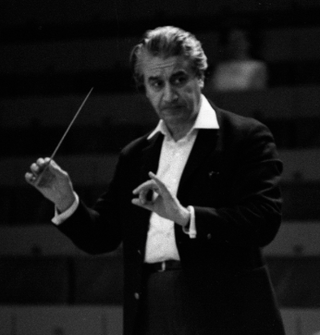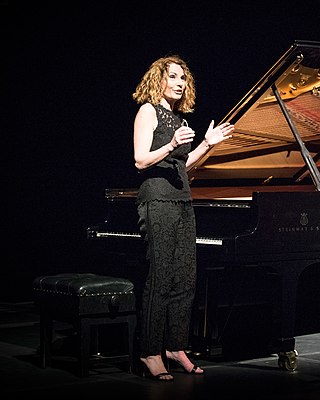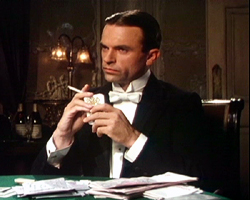
James Burke is a broadcaster, science historian, author, and television producer. He was one of the main presenters of the BBC1 science series Tomorrow's World from 1965 to 1971 and created and presented the television series Connections (1978), and its more philosophical sequel The Day the Universe Changed (1985), about the history of science and technology. The Washington Post has called him "one of the most intriguing minds in the Western world".

Tubular bells (also known as chimes) are musical instruments in the percussion family. Their sound resembles that of church bells, carillons, or a bell tower; the original tubular bells were made to duplicate the sound of church bells within an ensemble. Each bell is a metal tube, 30–38 mm (1+1⁄4–1+1⁄2 in) in diameter, tuned by altering its length. Its standard range is C4–F5, though many professional instruments reach G5. Tubular bells are often replaced by studio chimes, which are a smaller and usually less expensive instrument. Studio chimes are similar in appearance to tubular bells, but each bell has a smaller diameter than the corresponding bell on tubular bells.

Sergiu Celibidache was a Romanian conductor, composer, musical theorist, and teacher. Educated in his native Romania, and later in Paris and Berlin, Celibidache's career in music spanned over five decades, including tenures as principal conductor of the Munich Philharmonic, Berlin Philharmonic, Sicilian Symphony Orchestra and several other European orchestras. Later in life, he taught at Mainz University in Germany and the Curtis Institute of Music in Philadelphia, Pennsylvania.

Serge Koussevitzky was a Russian and American conductor, composer, and double-bassist, known for his long tenure as music director of the Boston Symphony Orchestra from 1924 to 1949.

Seiji Ozawa was a Japanese conductor known internationally for his work as music director of the Toronto Symphony Orchestra, the San Francisco Symphony, and especially the Boston Symphony Orchestra (BSO), where he served from 1973 for 29 years. After conducting the Vienna New Year's Concert in 2002, he was director of the Vienna State Opera until 2010. In Japan, he founded the Saito Kinen Orchestra in 1984, their festival in 1992, and the Tokyo Opera Nomori in 2005.

The Turangalîla-Symphonie is the only symphony by Olivier Messiaen (1908–1992). It was written for an orchestra of large forces from 1946 to 1948 on a commission by Serge Koussevitzky for the Boston Symphony Orchestra. Along with the Quatuor pour la fin du temps, the symphony is one of the composer's most notable works.

Joanna Clare MacGregor is a British concert pianist, conductor, composer, and festival curator. She is Head of Piano at the Royal Academy of Music and a professor of the University of London. She was artistic director of the International Summer School & Festival at Dartington Hall from 2015 to 2019.

Reilly, Ace of Spies is a 1983 British television programme dramatizing the life of Sidney Reilly, a Russian-born adventurer who became one of the greatest spies ever to work for the United Kingdom and the British Empire. Among his exploits, in the early 20th century, were the infiltration of the German General Staff in 1917 and a near-overthrow of the Bolsheviks in 1918. His reputation with women was as legendary as his genius for espionage.
Myung-whun Chung is a South Korean conductor and pianist.
This is the discography of Simon Rattle and other produced works by the English conductor.
Gardens of the World with Audrey Hepburn was a 1990s documentary television series filmed on location in some of the world's most beautiful, noteworthy gardens, hosted by Audrey Hepburn, who also co-narrates the series with Michael York.
Michail Vladimirovich Jurowski was a Russian conductor who worked internationally, based in Germany for most of his career. He was particularly interested in the works of Dmitri Shostakovich, in concerts and recordings.
This is a complete list of recordings by the Los Angeles Philharmonic, shown alphabetically by conductor, and then by recording label.
With its debut in 1993, the Pacific Symphony Youth Orchestra(PSYO) became the first educational program of Pacific Symphony and is now one of four youth orchestras in the Pacific Symphony Youth Ensembles (PSYE) program. Pacific Symphony Youth Orchestra gives an opportunity to young, talented musicians in the Orange County and Inland Empire areas to grow and be trained as orchestral musicians. Composed of youth in grades 9 through 12, members of PSYO are given the opportunity to work with the professional musicians of Pacific Symphony and are led by Jacob Sustaita, Assistant Conductor of Pacific Symphony. PSYO currently performs its annual concert series in the Renée and Henry Segerstrom Concert Hall at the Segerstrom Center for the Arts.
Olli Mustonen is a Finnish pianist, conductor, and composer.
Ancient Airs and Dances is a set of three orchestral suites by Italian composer Ottorino Respighi, freely transcribed from original pieces for lute. In addition to being a renowned composer and conductor, Respighi was also a notable musicologist. His interest in music of the Renaissance and Baroque periods led him to compose works inspired by the music of these periods.
The keyboard section of an orchestra or concert band includes keyboard instruments. Keyboard instruments are not usually a standard members of a 2010-era orchestra or concert band, but they are included occasionally. In orchestras from the 1600s to the mid-1750s, a keyboard instrument such as the pipe organ or harpsichord was normally played with an orchestra, with the performer improvising chords from a figured bass part. This practice, called basso continuo, was phased out after 1750.
The Washington Symphonic Brass is an American professional modern brass ensemble, and a not-for-profit 501- (c)(3) arts organization. The ensemble performs in the Washington, DC, Maryland, and Northern Virginia areas. The WSB presents live concerts, produces commercial recordings, and educates young brass and percussion musicians. The WSB is the Ensemble-in-Residence at George Mason University and is a collaborative artist with the National Philharmonic Orchestra, the Fairfax Choral Society, and the Amadeus Orchestra.
Composition for Twelve Instruments is a serial music composition written by American composer Milton Babbitt for flute, oboe, clarinet, bassoon, horn, trumpet, harp, celesta, violin, viola, cello, and double bass. In it Babbitt for the first time employs a twelve-element duration set to serialize the rhythms as well as the pitches, predating Olivier Messiaen's (non-serial) "Mode de valeurs et d'intensités", but not the Turangalîla-Symphonie (1946–1948), in which Messiaen used a duration series for the first time in the opening episode of the seventh movement, titled "Turangalîla II".
A duration row or duration series is an ordering of a set of durations, in analogy with the tone row or twelve-tone set.








